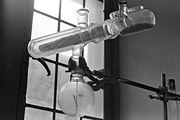
Abderhalden's drying pistol
Encyclopedia

Laboratory glassware
Laboratory glassware refers to a variety of equipment, traditionally made of glass, used for scientific experiments and other work in science, especially in chemistry and biology laboratories...
used to free samples
Sample (material)
In general, a sample is a limited quantity of something which is intended to be similar to and represent a larger amount of that thing. The things could be countable objects such as individual items available as units for sale, or a material not countable as individual items. Samples of countable...
from traces of water, or other impurities. It is called a "pistol" because of its resemblance to the firearm
Pistol
When distinguished as a subset of handguns, a pistol is a handgun with a chamber that is integral with the barrel, as opposed to a revolver, wherein the chamber is separate from the barrel as a revolving cylinder. Typically, pistols have an effective range of about 100 feet.-History:The pistol...
. This apparatus was first described in a book edited by Emil Abderhalden
Emil Abderhalden
Emil Abderhalden was a Swiss biochemist and physiologist. His main findings, though disputed already in the 1920s, were not finally rejected until the late 1990s. Whether his misleading findings were based on fraud or simply the result of a lack of scientific rigor remains unclear...
. The drying pistol allows the sample to be dried at elevated temperature
Temperature
Temperature is a physical property of matter that quantitatively expresses the common notions of hot and cold. Objects of low temperature are cold, while various degrees of higher temperatures are referred to as warm or hot...
; this is especially preferred when storage in a desiccator
Desiccator
thumb|right|A desiccator and a vacuum desiccator - note the stopcock which allows a vacuum to be applied. The blue [[silica gel]] in the space below the platform is used as the [[desiccant]]....
at room temperature does not give satisfactory results.
Operation
The drying pistol consists of two concentric barrels; the inner is connected to a vacuum source via a trap. The outer barrel is connected at the bottom to a round bottom flask, and a condenserCondenser (laboratory)
In a laboratory a condenser is a piece of laboratory glassware used to cool hot vapors or liquids. A condenser usually consists of a large glass tube containing a smaller glass tube running its entire length, within which the hot fluids pass....
. To operate the drying pistol, a sample
Sample (material)
In general, a sample is a limited quantity of something which is intended to be similar to and represent a larger amount of that thing. The things could be countable objects such as individual items available as units for sale, or a material not countable as individual items. Samples of countable...
is placed within the inner barrel, and the barrel is evacuated. The round bottom flask, filled with an appropriate solvent, is heated to a boil. Hot vapors warm the inner barrel; losses are avoided with the condenser. By choosing the appropriate solvent, the temperature at which the sample is dried can be selected.
The trap is filled with an appropriate material: water is removed with phosphorus pentoxide
Phosphorus pentoxide
Phosphorus pentoxide is a chemical compound with molecular formula P4O10 . This white crystalline solid is the anhydride of phosphoric acid. It is a powerful desiccant.-Structure:...
, acidic gases by potassium
Potassium hydroxide
Potassium hydroxide is an inorganic compound with the formula KOH, commonly called caustic potash.Along with sodium hydroxide , this colorless solid is a prototypical strong base. It has many industrial and niche applications. Most applications exploit its reactivity toward acids and its corrosive...
or sodium hydroxide, and organic solvents by thin pieces of paraffin. Generally, the main impurity to be removed is water.
This set-up allows the desiccation of heat-sensitive compounds under relatively mild conditions. Removing these trace impurities is especially important to give good results for elemental analysis
Elemental analysis
Percent Composition is a process where a sample of some material is analyzed for its elemental and sometimes isotopic composition. Elemental analysis can be qualitative , and it can be quantitative...
and gravimetric analysis
Gravimetric analysis
Gravimetric analysis describes a set of methods in analytical chemistry for the quantitative determination of an analyte based on the mass of a solid...
.

